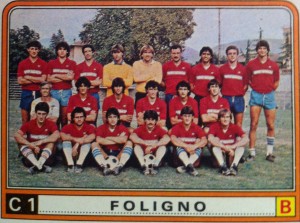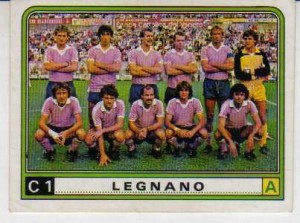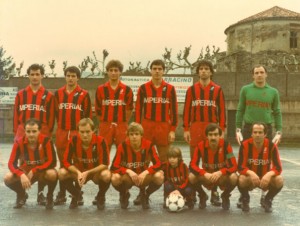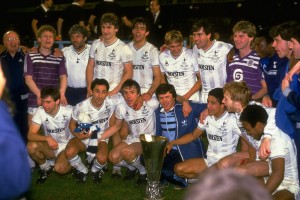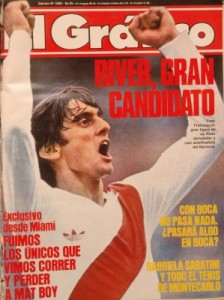Copa Libertadores. Gremio (Porto Alegre) qualified directly to the semif-final stage, the other teams played in 5 qualification groups as ever. Only the group winners qualified.
Group 1. Argentina and Paraguay. The battle was between Independiente (Avellaneda) and Olimpia (Asuncion). Estudiantes (La Plata) somewhat curiously, given their strong form in the Argentine championship, failed. At the end goal-difference decided the winner. As a note for the future: 18-years old Jose Luis Chilavert debuted internationally, playing a game for Sportivo Luqueno.
1.Independiente (Avellaneda) 6 4 1 1 11- 5 9
2.Olimpia (Asunción) 6 4 1 1 8- 5 9
3.Sportivo Luqueño (Asunción) 6 0 3 3 2- 6 3
4.Estudiantes (La Plata) 6 0 3 3 4- 9 3
Group 2. Bolivia and Chile. O’Higgins (Rancagua) was the outsider, but otherwise the group had expected outcome.
1.Universidad Católica (Santiago) 6 4 1 1 11- 5 9
2.Blooming (Santa Cruz) 6 3 2 1 10- 6 8
3.Bolívar (La Paz) 6 2 2 2 10- 8 6
4.O’Higgins (Rancagua) 6 0 1 5 4-16 1
Group 3. Brazil and Colombia. Santos was weakest, who knows why. America put some fight, but Flamengo was head and shoulders above the opposition.
1.Flamengo (Rio de Janeiro) 6 5 1 0 19- 6 11
2.América (Cali) 6 3 1 2 8- 9 7
3.Atlético Junior (Barranquilla) 6 2 0 4 9-12 4
4.Santos 6 1 0 5 5-14 2
Group 4. Ecuador and Uruguay. El Nacional was a bit of a surprise, but still the winner was the expected one.
1.Nacional (Montevideo) 6 4 1 1 13- 5 9
2.El Nacional (Quito) 6 3 2 1 12- 6 8
3.Danubio (Montevideo) 6 2 1 3 8- 8 5
4.Nueve de Octubre (Milagro) 6 0 2 4 7-21 2
Group 5. Peru and Venezuela. The only group with unexpected winner – here the final table only after a play-off between Universidad Los Andes (Merida) and Sporting Cristal (Lima), for both teams ended with equal points and +2 goal-difference. The match was played on neutral ground in Cali and the Venezuelans prevailed 2-1.
1.Universidad Los Andes (Mérida) 6 4 0 2 6- 4 8
Sporting Cristal (Lima) 6 4 0 2 8- 6 8
3.Portuguesa (Acarigua) 6 3 0 3 9- 7 6
4.Mariano Melgar (Arequipa) 6 1 0 5 5-11 2
In the semi-final stage Independiente was very strong, leaving the others well behind in Group 1.
1.Independiente (Avellaneda) 4 2 2 0 4- 2 6
2.Nacional (Montevideo) 3 1 1 1 3- 2 3
3.Universidad Católica (Santiago) 3 0 1 2 1- 4 1
Group 2 was more dramatic, for there were two Brazilian rivals of grand standing – Gremio, current holders of Copa Libertadores, and Flamengo, also very strong and ambitious internationally. The Venezuealan team was only a punching bag and point-provider. Gremio and Flamengo finished with equal points and went to a play-off, for at this stage goal-difference was not immediate tie-braker. The rivals played in Sao Paulo and there was still no winner – 0-0. And only now goal-difference played a role – Gremio’s was better and the finished first and went to the final.
1.Grêmio (Porto Alegre) 4 3 0 1 14- 5 6
Flamengo (Rio de Janeiro) 4 3 0 1 9- 7 6
3.Universidad Los Andes (Mérida) 4 0 0 4 2-13 0
The big two-legged final at last. Gremio, the current holders, aiming for a consecutive second cup, against the club, which won most cups to this date – Independiente.
Gremio hosted the first leg and to the dismay and disappointment of the fans in Porto Alegre, Burruchaga scored the only goal of the match. Nothing was finished yet, but Independiente was leading and had the home advantage. Gremio did its best in hostile Avellaneda and did not lose. But it did not win either, the match ending scoreless 0-0. Naturally, the stadium erupted – what greater moment than winning the coveted trophy in front of home fans.




The moment of triumph – rightly Kings of Cups! The capital of the football world was Avellaneda.

Bitter pill to swallow for Gremio. They conquered the world in 1983 and naturally aimed to do it again in 1984 – in general, they had the same winning team. May be not particularly starry squad, but experienced, stable, players well adjusted to each other. The big names and leaders were Renato Gaucho and the Uruguayan defender Hugo de Leon – quite enough for class, toughness, and inspiration. But 1983 was not repeated – Gremio fought well, was a bit lucky at the semi-finals, came close at the finals, and lost minimally. Unfortunately, the opposition was slightly stronger.

In 1984, Independiente did more than just winning Copa Libertadores – they became the most internationally successful club in the world! This was their 7th Copa Libertadores – Real Madrid was left behind with their 6 European Champions Cups.
Sitting from left: Tourino (?) – assistant coach, Cirinsione (?) – coach, Sanchez, Percudani, Merlini, Bufarini, Zimmermann, Carizzo (?), Reinoso, Barberon, Serusi – masseur.
Middle row: Jose Pastoriza – head coach, Fennema (?) – assistant coach, Rios, Enrique, Marangoni, Krnko (?), Monzon, Villaverde, Wiktor, Guisti, Adorno (?) – assistant coach.
Top row: Kenny – condition coach, Clara, Trossero, Oviedo, Moriconi, Goyen, Prono, Clausen, Burruchaga, Chicolio (?) – doctor.
Foure players are missing here: Mario Killer (who moved to play for Rosario Central), Rene Houseman (fading by now and just arriving from a spell in South Africa, he played miniscule role, appearing only once in the Copa Libertadores campaign and that as a substitute), the Chilean reserve goalkeeper Sergio Vargas, and Ricardo Bochini. It is a shame Bochini is not on the photo, for he was already Mr. Independiente – rightly, he is considered the all-time best player of the club, a massive star at the time – unfortunately, not well known outside Argentina, for he was rarely called to play for the national team and never moved to Europe – and the driving force of the team for many years. The whole period is called “Bochini era’, so huge was his importance for the club he was loyal to his last playing day. Of course, it was not just him – there were up and coming Burruchaga, Guisti, Trossero, Clausen, Villaverde, Monzon, Percudani. A well assembled squad, coached by former big star Jose Pastoriza. Yet, compared to the all-conquering teams of the 1970s, it was somewhat limited team – thus, differently oriented, centered on Bochini, driven by Bochini. And this peculiarity or limitation shows: as good as it was, this Independiente vintage was not capable of fighting on two, not to mention three fronts. Thus, it seems that they focused on Copa Libertadores and just went though the motions in the domestic championships. Well rewarded decision, but also suggesting that this squad was not going to make a dynasty. Not to be discarded as one time wonder, though – it was a team good enough for one challenge and it was important to make the right choice on which championship to concentrate the efforts. Of course, Independiente was not going to leave things as they were, especially with the ever-present danger of losing stars to European, Mexican, or other South American clubs, but it was not that much of reinforcement – rather, keeping up decent squad by finding classy replacement for those who were going elsewhere. Given the circumstances, Independiente did better than most Argentine clubs, staying constantly strong. But that is general observation of a period going well beyond 1984 – for this year the club became the most successful in the world coming ahead of Real Madrid after winning its 7th Copa Libertadores and that was not even all that happened. As a novelty, Independiente even came ahead in the Uruguayan battle – the star defender Hugo de Leon was key player of Gremio. His practically unknown countryman, the goalkeeper Carlos Goyen prevailed and lifted Copa Libertadores. Well, this chapter ended, another one is coming.






















